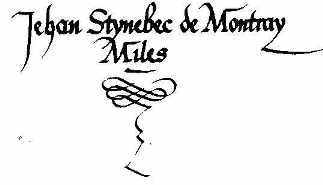“Perhaps a passionate love for the English language opened to me from this one book.” ~John Steinbeck, Introduction to The Acts of King Arthur and His Noble Knights (1976)
Thomas Malory’s Le Morte D’Arthur meant this much to Steinbeck, and more. If ever there was a love story of knightly proportions, it was this adventure of his lifelong relationship to the 15th-century Arthurian classic. He first swore fealty to it when he was 9–or, “whan of IX wyntre age,” as he would later pen in his moving dedication to his sister Mary. He confesses (in his Introduction) to some difficulty when he first faced the task of reading: “words–written or printed–were devils, and books, because they gave me pain, were my enemies.” Then a magical thing happened. His aunt gave him a cut copy of William Caxton’s Morte d’Arthur (first published in 1485) in bold, black print and with the original spellings intact. The mystery of words such as hyght and cleave, fyaunce and yclept, drew him into a secret world with a secret language, one he shared only with his “squire,” his 6-year-old sister (in the dedication he raises her to full knighthood). He was held by their enchantment–“oddly enough I knew the words from whispering them to myself,” he recalled. These tales convinced him of their solid human reality, and he discovered in their scenes
“all the vices that ever were–and courage and sadness and frustration, but particularly gallantry. I think my sense of right and wrong, my feeling of noblesse oblige, and any thought I may have against the oppressor and for the oppressed, came from this secret book.”
Malory’s panorama of life sustained Steinbeck through childhood and inspired careful research and devoted investigation of its sources in adulthood. Finally, in 1956, Steinbeck, the successful novelist, allowed himself the privilege of turning his whole attention upon his first love and undertaking the great task of fashioning his own version of Malory, somewhere between a translation and a retelling. From his letters, we know that he continued working on it until 1965. It was unfinished at his death in 1968, but his manuscript was published by his wife Elaine in 1976, along with an Appendix of his letters from that period (edited by Chase Horton) which chart his research and writing process in illuminating detail.
The stories included in this book are a tremendous treasure, and we are lucky to have them. I chose to read Steinbeck’s stories first before referring to the letters, in order to form my own impressions, but I did refer to Malory along the way for comparison, to see how he remolded the language and to look for Steinbeck’s alterations and expansions. (Malory, of course, was retelling the Arthurian cycle as he knew it from the “Frensshe” books of Chrétien de Troyes and others.) Although Steinbeck’s first love was Caxton’s printing of Malory’s text, his research and discussions with Arthurian scholars, such as Eugène Vinaver, led him to adopt the Winchester manuscript of Malory as his foundational text for “translation.” He felt it was closer to Malory’s own phrasing and had not gone through the filter of whatever editing or cutting Caxton had chosen to do. The Winchester manuscript (abridged, with modernized spellings) is available to the general reader in an Oxford World Classics edition.
Since I hope to convey my appreciation of Steinbeck’s telling, I will share a few of these comparisons, and then take up the romance of his writing process by considering what the letters reveal in a second post (see Steinbeck’s Malory II: The Writing of “The Acts of King Arthur and His Noble Knights”).
Steinbeck’s Malory tells seven tales: “Merlin,” which recounts Arthur’s birth, and ascension to kingship; “The Knight with Two Swords,” the story of Balin and his twin Balan; “The Wedding of King Arthur,” which also includes an early quest of Sir Gawain; “The Death of Merlin,” from his own folly, and through the craft of the sorceress Nyneve; “Morgan Le Fay”; “Gawain, Ewain, and Marhalt”; and “The Noble Tale of Sir Lancelot of the Lake.” Steinbeck felt that Malory’s writing grew in sophistication as his work proceeded, and correspondingly, Steinbeck adds more of his own observations and expansions of incidents in the later stories, especially in the tale of Lancelot. However, even in such an early incident as the appearance of Merlin to Sir Ulfius, Steinbeck added to Malory’s report of the incident.
First, Malory [Ref. 2, p. 4]:
[King Uther Pendragon:] ‘I am sick for anger, and for love of fair Igraine, that I may not be whole.’
‘Well, my lord,’ said Sir Ulfius, ‘I shall seek Merlin, and he shall do you remedy, that your heart shall be pleased.’
So Ulfius departed. And by adventure he met Merlin in a beggar’s array, and there Merlin asked Ulfius whom he sought; and he said he had little ado to tell him.
‘Well,’ said Merlin, ‘I know whom thou seekest, for thou seekest Merlin; therfore seek no further, for I am he….’
Now, Steinbeck [Ref. 1, p. 4]:
[King Uther Pendragon:] “I am sick from anger and from love and there are no medicines for those.”
“My lord,” Sir Ulfius said, “I shall go in search of Merlin the Wizard. That wise and clever man can brew a remedy to make your heart glad.” And Sir Ulfius rode out to look for Merlin.
Now Merlin was a wise and subtle man with strange and secret powers of prophecy and those deceptions of the ordinary and the obvious which are called magic. Merlin knew the winding channels of the human mind, and also he was aware that a simple open man is most receptive when he is mystified, and Merlin delighted in mystery. Therefore, as if by chance, the searching knight Sir Ulfius came upon a ragged beggar in his path who asked him who he sought.
The knight was not accustomed to be questioned by such a one, and he did not deign to reply.
Then the ragged man laughed and said, “There’s no need to tell me. I know. You are looking for Merlin, Look no further. I am Merlin.”
“You–? You are a beggar,” said Sir Ulfius.
Merlin chuckled at his joke. “I am also Merlin,” he said.
Steinbeck chose carefully those phrases with which to modernize and clarify the incident, but his biggest change was his narrative aside, commenting on the psychology of Merlin and the knight. (Interestingly, I now see that Sherlock Holmes was a Merlin among detectives, who knew how to mystify his clients upon first meeting with his powers of observation, and thereby gain the most from the initial interview.) As I read Steinbeck’s Malory, whenever I came upon certain psychological insights such as this one, I guessed that they were more like Steinbeck, the novelist, than Malory, the brilliant, but terse storyteller.
Steinbeck sometimes put these psychological enhancements into the mouth of a character, or into a little dialogue not found in Malory. After Arthur’s fight with King Pellinore, Arthur bemoaned his defeat and the loss of his sword and wondered how he could still consider himself a knight. Merlin answered him,
“…there is more to a king than a crown, and far more to a knight than a sword. You were a knight when you grappled Pellinore unarmed.”
“And he defeated me.”
“You were a knight,” said Merlin. “Somewhere in the world there is defeat for everyone. Some are destroyed by defeat, and some made small and mean by victory. Greatness lives in one who triumphs equally over defeat and victory. But you want a sword. Very well, you shall have one….” [Steinbeck, p. 44]
And the story continued with the revelation of Excalibur and its magic scabbard.
When Merlin disclosed to Arthur that his, Merlin’s, death was near, Arthur wondered why Merlin could not use his arts to save himself from an end he could foresee. In Malory, Merlin simply said, “Nay, it cannot be.” But Steinbeck (p. 99) let Merlin explain, “Because I am wise. In the combat between wisdom and feeling, wisdom never wins.” Merlin then connected his own downfall to Arthur’s foretold future, one where he would let feeling lead him on to his fate. In these early stories, Steinbeck felt a special kinship to Merlin, a wise man betrayed by passions, as he looked back over his own life. Later he would find his heart and soul in the story of Lancelot, the exceedingly noble and flawed knight, the best of them all.
Steinbeck began to give himself greater scope in his treatment of “The Noble Tale of Sir Lancelot of the Lake.” At its opening, he chose to reflect longer than Malory did about the paradoxical problem of knights who seek peace but are trained only for war and therefore become restless. Tournaments among the Knights of the Round Table answered this need, but for Sir Lancelot, “a stringless bow,” they were not enough and he set off in quest of knightly adventure, with his nephew Lyonel as squire. In an amusing creation of his own, Steinbeck had Guinevere suggest this idea in conversation with Arthur, who in turn allowed Lancelot to come to the necessary conclusion apparently on his own.
When Lancelot slept beneath an apple tree, and was abducted by four queens–who, including Morgan Le Fay, were also four witches–Steinbeck expanded the story greatly, as each queen elaborately pled her suit to have Lancelot choose her. Likewise, in the adventure where Sir Lancelot and Sir Kay exchanged shields, just a few words between them alter the entire motivation and bring out Lancelot’s newfound compassion for the other knight. In another episode (involving a lady, her hawk, and a trap set by her husband) Steinbeck went beyond the plain facts and straightforward emotions as Malory laid them out, delved into Lancelot’s thoughts, and added his psychological commentary (p. 277):
“As he went along his way he thought in saddened wonder about the man he had killed. Why was his hatred so great against Lancelot, who had done him no harm? He was innocent of those passions of jealousy which cause a small man to destroy what others admire, nor had he so far in his life felt the self-loathing that makes a man revenge himself on a world he blames for his own inadequacies.”
When Sir Lancelot at last returned to the court at Winchester, he resumed his “gold-lettered seat” at the Round Table and had to listen to the litany of his knightly deeds (p. 287). Wearily, he dozed as the stories grew in proportion to his fame, “exalted beyond his recognition,” and he wished to be anywhere else at that moment. He had reached the point where a man “becomes the receptacle of the wishful longings of the world,” and yet he was still alive. He found it most difficult to be a living legend. Steinbeck’s tale ended as Lancelot’s longing for Guinevere first overcame his loyalties with a betrayal, thus making the final quote from Malory both poignant and ironic (p. 293):
“And so at that tyme sir Lancelot had
the grettyste name of ony knyght of the worlde,
and moste he was honoured of hyghe and lowe.”
Sadly, Steinbeck did not finish the story of Arthur nor did he write the Story of the Grail, the Sangreall. I would have dearly loved to see his treatment of this ultimate quest and his characterization of Sir Perceval. Perceval was the Arthurian character I chose for The Fictional 100, a character who has inspired the literature of several languages, as well as the musical language of opera.
Writing this book became a quest for him (see Steinbeck’s Malory II). It was one of the last, heroic acts of the noble Knyght, Jehan Stynebec de Montray. Here is his signature, in his own script, with which he concluded the book’s dedication.
References:
1. Steinbeck, John. The Acts of King Arthur and His Noble Knights: From the Winchester Manuscripts of Thomas Malory and Other Sources (Ed. by Chase Horton). New York: Farrar, Straus and Giroux, 1976. Includes an Appendix of his letters about this project from November 1956 to July 1965.
- A Penguin paperback edition (2008) makes this book, complete with Steinbeck’s letters, readily available again. It includes a new introduction by fantasy novelist Christopher Paolini.
2. Malory, Sir Thomas. Le Morte Darthur: The Winchester Manuscript (Ed. by Helen Cooper). Oxford: Oxford University Press, 1998. An abridged selection of Malory’s stories, with updated spellings.
3. Malory, Sir Thomas. Le Morte d’Arthur (Intro. by Elizabeth Bryan). New York: Modern Library, 1994. Complete Caxton text in one volume, with modernized spellings. It also has Caxton’s Book and Chapter headings, which are tremendously useful for finding particular episodes.
Related post:
- Visit Bibliographing for another Classics Circuit post on The Acts of King Arthur
Other stops on the Steinbeck Classics Circuit today:
- Reading Thru The Night East of Eden
- Meditations of a Teenage Philosopher East of Eden, Tortilla Flat, The Winter of Our Discontent





























Recent Comments